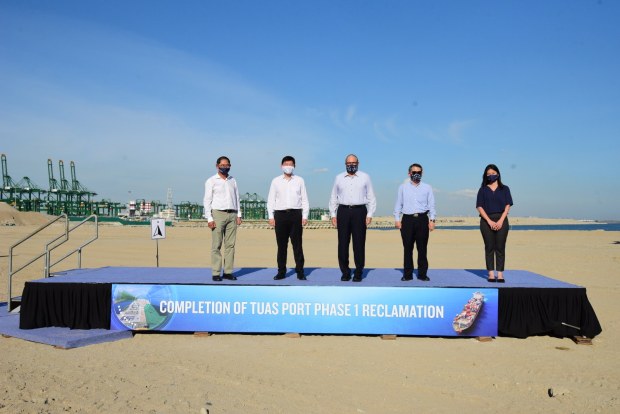“It has also highlighted the need to ensure business continuity and improve the resilience of maritime gateways, as ports act as crucial nodes in the global logistics system, keeping supply chains moving, economies functioning and people employed,” the report says.
Singapore vies with Shanghai for the title of the world’s biggest trans-shipment port. Tuas Port is designed to make the city-state an even more vital cog in the global trade wheel. It will be the world’s largest container terminal, capable of handling 65 million TEUs a year, almost double Singapore’s current port capacity.

A glimpse of Singapore’s future: MPA chairman Niam Chiang Meng, Senior Minster of State Chee Hong Tat, Transport Minister S. Iswaran, the Ministry of Transport”s Loh Ngai Seng, MPA CEO Quah Ley Hoon at Tuas Port Phase 1.
“Trade is our lifeblood and that’s why we invest heavily to be ahead of the game, to be relevant … Tuas Port is one of the key pillars to ensuring our future relevancy,” said MPA chairman Niam Chiang Meng at this week’s event.
About one-third of the containers that travel by sea to their final destination go through Singapore at some point, mostly on their way to somewhere else. Some of the 3 million-odd containers that pass through each month need to be transferred from one of the five existing container terminals to another.
These transfers can cause delays and costs that in turn affect Singapore Port’s competitiveness. Tuas Port will tackle this by consolidating operations into one central location, notes Toll Group’s managing director, Thomas Knudsen.
Australia fares badly
“The decision to move the operations from the current terminals makes a lot of sense,” says Knudsen, noting Toll City, the logistics and forwarding giant’s key facility in Singapore that opened in 2017, is sited near the new port.
“Long term, Singapore is well-positioned to remain the key global trans-shipment port. This is the right investment at the right time,” he said.
East Asia’s ports are the world’s most efficient, according to the World Bank Index. Tokyo’s Yokohama took out the top spot. Among the highest-ranked trans-shipment ports, Hong Kong and Taiwan’s Kaohsiung came ahead of Singapore, while nearby Malaysia’s Tanjung Pelepas and Port Klang were roughly in line.
Australia’s ports, beset by industrial action that has worsened since the World Bank’s index was released, fared badly. Out of the 351 ports included in the index, Sydney’s Port Botany was ranked 337th using the index’s statistical approach. Port Melbourne was 302 places down the line.
It is not particularly useful to line up largely single-destination ports such as Australia’s, where containers mostly come off and cargo gets distributed, to trans-shipment hubs, where containers transit through a port.
However, when Australian ports are compared to other single-destination cargo-handling centres, it is clear that if port performance was an Olympic sport, Australia would never be a medal hope.
Congestion at Port Botany has become so marked that some shipping lines are skipping the port entirely, the Australian Competition and Consumer Commission reported last month.
It found average idle hours – the length of time a ship spends in berth – at Port Botany increased from 11.9 hours pre-pandemic to 21.2 hours in 2020-21. This week, the Morrison government asked the Productivity Commission to look at the “broader issues” hampering the productivity of Australia’s ports.
The ACCC found poor performance has been exacerbated by MUA enterprise bargaining deals. The ACCC said these “contributed to the sub-optimal performance of the nation’s major ports and added to the pandemic-induced supply constraints” by “hampering productivity and increasing disruptions”.
Startling comparison
Just about everyone agrees Australian port costs are too high, and ultimately result in consumers paying more for goods. Some of this is due to lower volumes handled by destination ports and, in Australia at least, a lack of competition.
Trans-shipment ports have to keep costs down to keep ships calling in. Even so, the comparison between Singapore and Australia is startling. Insiders say port charges for a 5800-TEU vessel – these don’t include stevedoring costs – at Singapore are about $US15,000 versus $US53,000 at the Port of Melbourne.
Vertical integration across supply chains gives Singapore another avenue for growth. This week, port operator PSA International, which has grown from its Port of Singapore roots to running a global network, announced it was buying global logistics player BDP from Greenbriar Equity Group.
PSA, owned by the Singapore government’s Temasek Holdings, believes the supply chain pressure points exposed since the pandemic will lead to lasting changes. These include just-in-case ordering, as well as just-in-time, an acceleration of digital technology adoption or digitalisation, and customer demand for sustainability. The BDP purchase bolsters the port operator’s expansion into these areas.
Back at Tuas, Transport Minister S Iswaran told those assembled this week that investments in automation, digital technologies and ecosystem planning would cement Singapore position as “a major node in the global supply chain – well into the future”.
Automated cranes and driverless vehicles at Tuas Port will more than double labour productivity, compared to Singapore’s existing terminals. By speeding up bunkering and repair work, the turnaround time for ships should improve – as will Singapore’s reputation as a “catch-up” port. The port is also planning to operate at net zero emissions by 2050.
Taking the long view, the completion of the Phase One reclamation was an important development in Singapore’s storied maritime history, Iswaran said. “It’s not just the physical infrastructure It’s also the decarbonisation and the digitalisation trajectory. This is one more step on the journey – it’s a milestone,” he told AFR Weekend.


